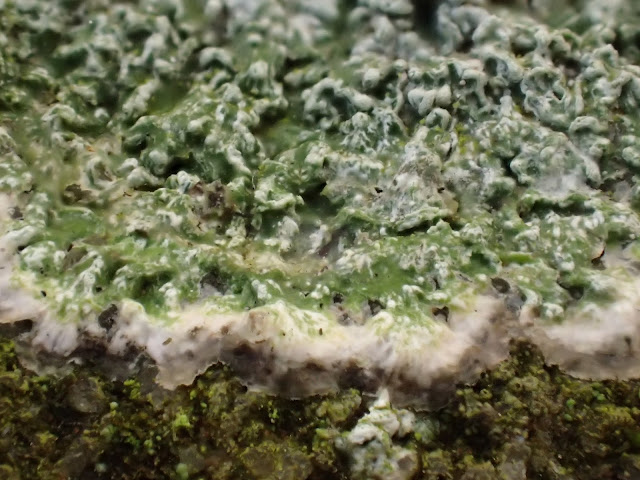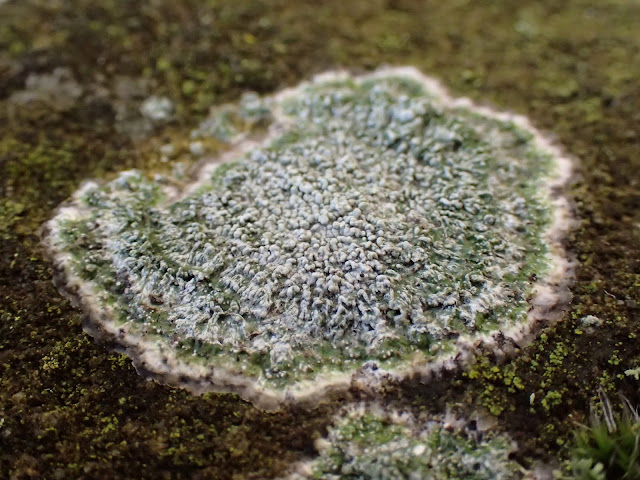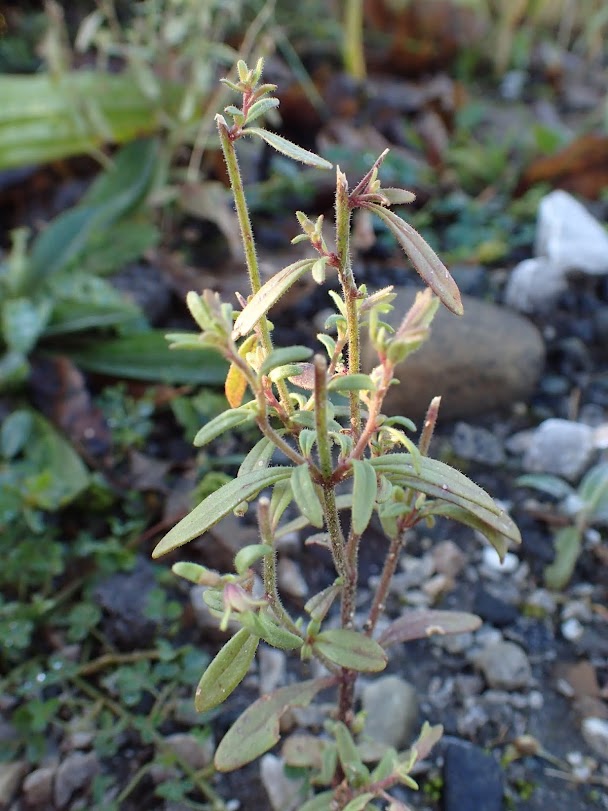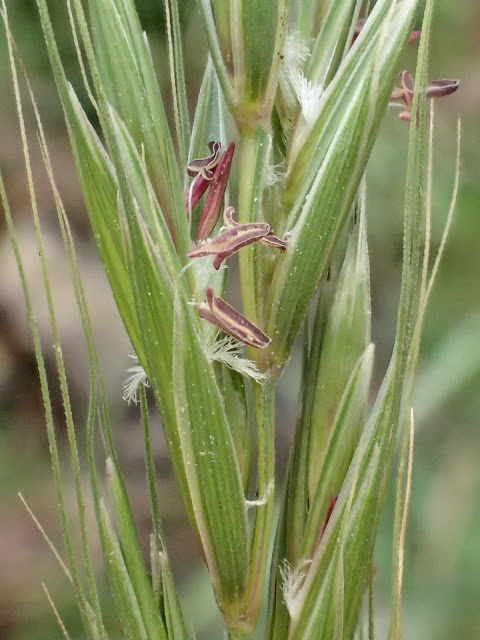,My walk leads from Gildersleets to Craven Arms, near Giggleswick Station, Settle, from 3pm till 4.15pm, by which time it is dark. I go on to make repeat walks on 30th and on 1 Dec.
Earlier in the year I had had walked past the end of this overgrown "forgotten" beck filled with waterside plants, left behind when the bypass was built, and had planned to go an explore it.
This blog post will talk about
- the Salix viminalis;
- the three walks I make to Swaw Beck and the Lichens I find.
- how I discover that Swaw Beck is the top end of Long Preston Deeps "Lake" and how it collects the water from the glacial overflow channels at Craven Ridge when ice flowed up from the Wenning Catchment (and the south of the Lake District).
Back to the Willow
Osier is used by basket makers because the young twigs are long and straight.
My willow does have three features of Crack Willow:- 1.very long narrow leaves, 2. it lookss like a tree, rather than a bush, and 3. the twig snapped easily off the parent branch.
However the following features are those of the Osier:
The under surface of the leaf has lots of appressed short silky hairs, (Crack willow leaves are hairless underneath)
The buds do not have a leaf scale
The bracts of the female flowers have lots of long silky hairs densely pilose (I dissected the bud)
Catkins appear before leaves in late Feb/March (though 29 Nov is a bit extreme) In Crack Willow the flowers appear later, at the same time as the leaves.
Now a digression to describe the Beck and the landforms and height of this part of Craven in more detail. Somehow it is satisfying to know how high or low one is in relation to surrounding features. to really be aware of one's place in the environment.

Swaw Beck is located at 131m above sea level
- at the top of "Lake of Long Preston Deeps"
To be precise, the track cutting of the Leeds-Giggleswick-Morecambe Line follows this lowest path. The surveyors in those days, with their chains, must have chosen the lowest route.
The drumlins between Hellifield and Gargrave are high too, where they blocked the Ribble. The railway cuts through the drumlins at about 151m. The Aire to the East is at 121m at Priesthome Bridge and the Ribble to the west now cut down to c122m at Cow Bridge These are estimates (www.cucaera.co.uk/)
Swaw Beck Lane is a tiny lane running parallel to the Bypass. It runs from Gildersleets to The Craven Arms near Giggleswick Station. The field between the Lane and the Bypass floods when Long Preston Deeps floods - so it is more or less the top end of the Long Preston Deeps Lake.
Amazing. Giggleswick Railway Station is built right over Swaw Beck. The beck emerges from under the railway station. Just think, when they built the Leeds Giggleswick Morecambe Line, they did not have bulldozers and mechanical diggers. Swaw Beck is fed by Storth Gill and also by Carr Beck which is fed by Craven Ridge Syke near Low Paley Green at 166 m Storth Gill Beck and Carr Beck both go underground (or must have been "put underground" )
and then emerge as Swaw Beck just SE of the Railway Bridge at Giggleswcik Station.
Lichens -
I may move this section to a separate lichens post for SD8062 -one day.
I am back surveying SD 8062.. only the 3rd monad in my hectad - yet I have approached this monad by five other routes - I see I recorded 25 species the first time and with other sites added it came to 42 - Let's see how I do restricting myself to Shaw Beck Lane.
After leaving my car at Gildersleets, at the beginning of the lane I meet Geoff Naylor, a member of Craven Conservation Group. "What, you have never been along this lane before!" he says with surprise.
 |
| Swaw Beck Lane - the beck on the right. The lichen on the tarmac is Verrucaria muralis |
 |
| Rather wet Verrucaria muralis |
 |
| Some Punctellia subrudecta on the wall. The soralia (powdery lumps) go red when bleach is applied |
 |
| Not sure what this lichen is. It has yellowish soralia (powdery lumps) The blob of bleach near my finger on the right turned slightly yellow. |
The wall by the lane is made mostly out of sandstone with the odd brick, limestone rock and lump of tarmac thrown in. The field on the west (the one that floods) is reseeded. The wall has lots of alga- Klebsormidium crenulatum and others on it, no doubt fertilised by spray manure and fertiliser. There are some ash trees along the lane overhanging the wall, which is why I found some tree species on the wall. e.g. Pertusaria amara (peppery rather than bitter taste.. though it got more bitter later) .. The beck and trees by the beck in the north half had just been cut or trimmed or pruned, and some branches shredded and left on the verge.
Parmelia saxatilis
Punctelia subrudecta
Physcia adscendens
Xanthoria parietina
Candelariella vitelina
Lecanora campestris
Porpidia tuberculosa
Pertusaria amara (under ash)
Lecanora gangaleoides/Tephromela atra
Physconia grisea?
On the trees themselves, the usual:
Lecidella eleochroma
Lecanora chlaroterra
Physcia tenella
Arthonia radiata
By the time I have crossed the bypass to the extension of Swar Beck lane and Beck beside the Railway it railway bridge (Just before Giggleswick Station) it is beyond twilight I turn round to come home - and on the most wooded bank notice a Peltigera (Dog Lichen) - I pluck a small piece in the dark, expecting it to be P membranacea. (Well it nearly always is, isn't it? - or if in grassland P hymenina). Now I have come home (via the Fish and Chip Shop to remove the taste of the P amara) to the light I see it has wonderful folioles/isidia and the undersurface has black raised veins with pale thallus in between. the rhizines are almos simple - So at SD804628 it is
Peltigera praetextata.
Total: 15 lichen species.
Ah we need to get up to 18 species for the map to "change colour" to yellow
30 Nov:
I repeat the walk. Extra species:
Lecanora soralifera
Rhizocarpon geographicum
Protoblastenia rupestris (on cement)
Aspicilia calcarea (on limestone)
Aspicilia contorta (on limestone)
Well that get it up to 20... .
1 Dec: At 11.30am and on a bright day though the clouds now covered the sun, I set off again.
Melanelixia fuliginosa
Acarospora fuscata
Caloplaca flavescens on limestone
Verrucaria muralis on mortar on wall at Bypass
Ochrolechia parella
Lepraria incana
Ramalina farinosa on an alder?
Opegrapha scripta - On alder
Normandina pulchella -On Alder
Lecanora dispersa - in Wall top rock
Up to 30 ! Hmm - my three trips along the lane have gained m e 30 species.
This scrapes me into the next colour band 29-40 is for the next colour change- pale orange
then 41-55 is dark orange.
----
Well I have added new species seen at Swaw Beck to the rest of the list for SD8062, and the total is now 50. Which is my highest score for a monad, beating rivals at Huntworth Common and Winskill Stones. (There are 7 monads in the hectad recorded by others with scores over 56.- I have a long way to go)
26 December - Ah a careful reanylisis of my recording sheet shows my total of different species in SD8062 is actuall 54!!


















































